In this article:
Best Car Battery Chargers from China
We promise to provide you with the best quality and the most cost-effective car battery chargers from China.
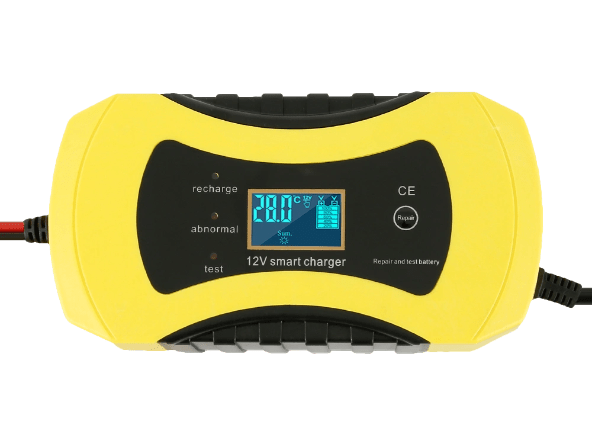
12V8A
ASL Car Battery Charger
Adopts a touch button design. Support summer/winter charging mode for lead acid batteries. Multiple protection measures for safety.
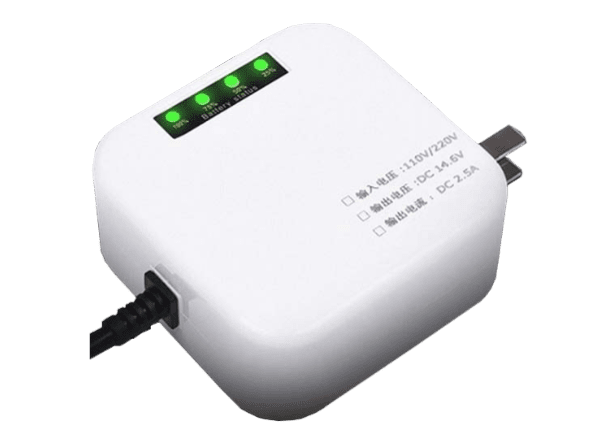
12V2A DVASL Car Battery Charger
Support dual voltage charging mode. Self-adaptive for different types of lead acid batteries. Adopts a mini design for convenient portable use.
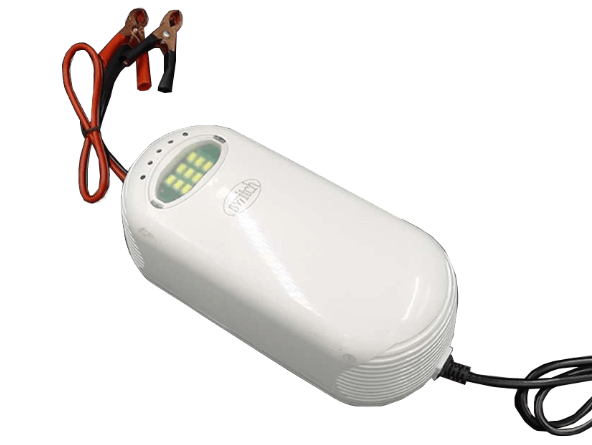
12V LMS
Car Battery Charger
Smart car battery charger with music reminder. Touch control smart lighting for dark environment. Multiple protection measures.
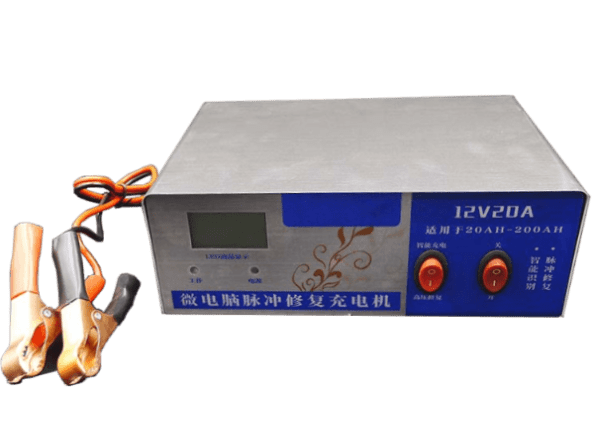
12V20A MCPR Car Battery Charger
Equipped with a micro-computer chip to realize a pulse repair function. It is applicable for charging both dry and wet lead acid batteries.
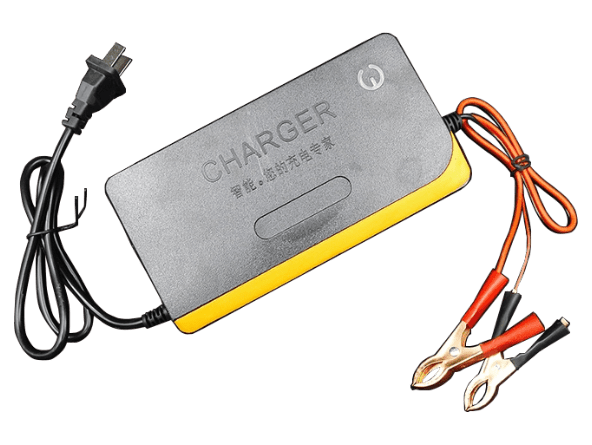
12V6A SL Car Battery Charger and Restorer
Features imported PWM control chip and voltage control technology. Auto power-off function and multiple protection measures for safety.
A car battery charger that matches your car’s battery can avoid potential starting difficulties due to battery problems. It can also be used to repair batteries with sulfation problems and extend their service life.
The following are several car battery chargers we have tested. By sharing our experience, we hope it will help you to choose your car battery charger.
5 Best Car Battery Chargers
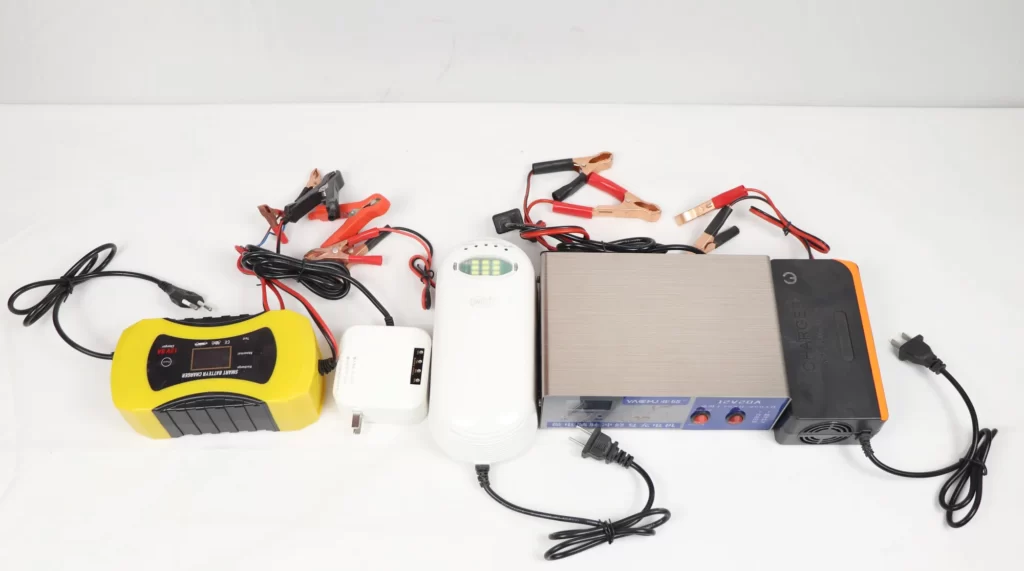
1.Best Smart Car Battery Charger: 12V8A ASL Car Battery Charger
2.Best Portable Car Battery Charger: 12V2A DVASL Car Battery Charger
3.Best Multifunction Car Battery Charger: 12V LMS Car Battery Charger
4.Best Pulse Repair Car Battery Charger: 12V20A MCPR Car Battery Charger
5.Best Car Battery Restorer: 12V6A SL Car Battery Charger and Restorer
#1 Best Smart Car Battery Charger: 12V8A ASL Car Battery Charger
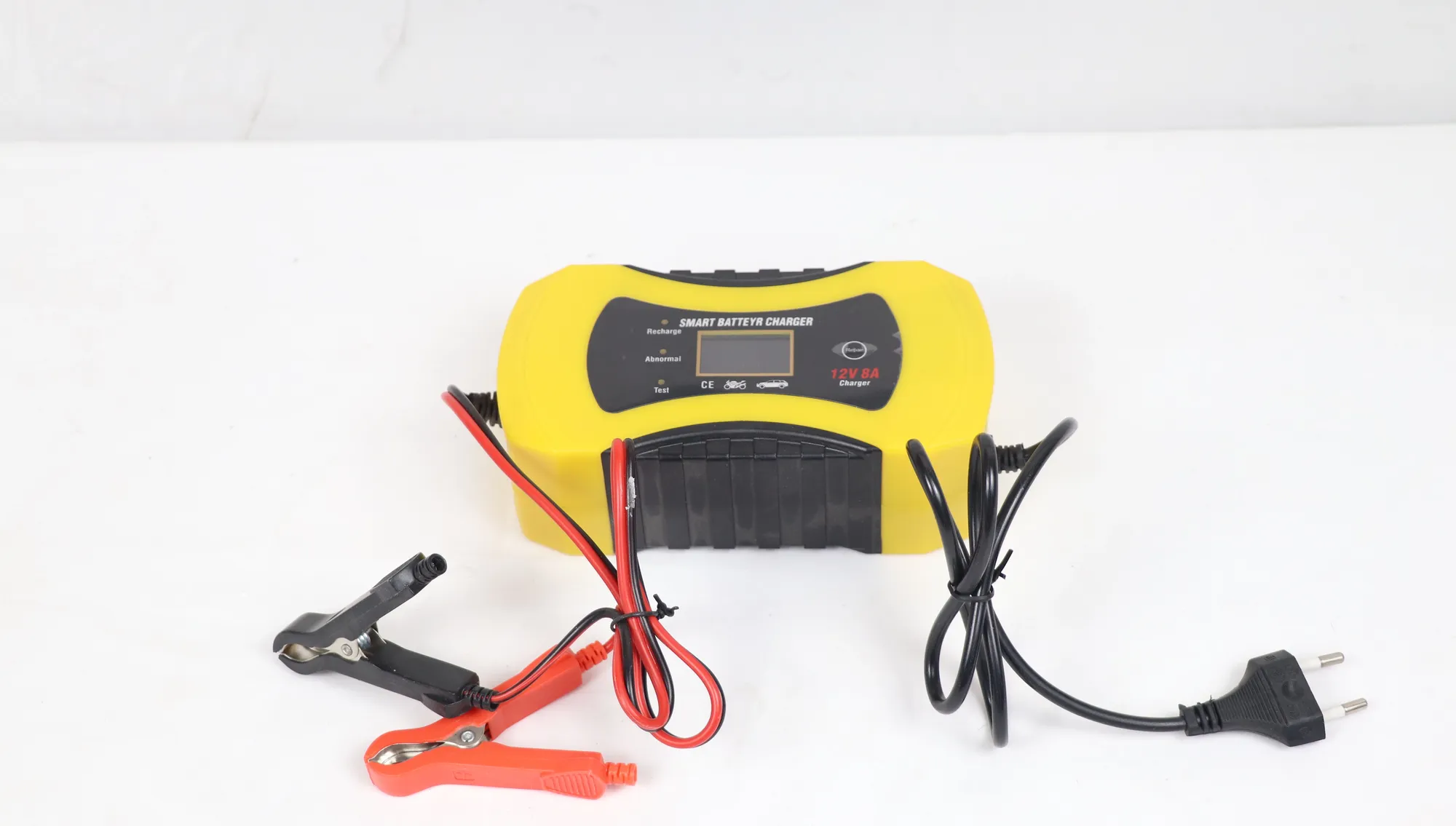
Pros
LCD screen displays real-time working status
Supports summer and winter charging modes
Multiple protection measures to ensure safety
High quality clamps
Cons
Can only charge 12V lead acid batteries
12V8A ASL is a smart car battery charger for daily portable use. It’s lightweight, portable, and easy to set up. Its output voltage can be stable at 14,4V, which is ideal for charging general 12V car batteries. Its auto detection function can monitor the battery level and turns itself off when it is fully charged. For lead acid batteries’ different conditions in hot and cold seasons, 12V8A ASL can switch itself between summer and winter modes.
Key Features
Price: $9.90
Weight: 0.45kg
Amperage: 10A
Voltage: 14.4V
Battery Types: Standard (wet cell)/AGM/Gel/Ca/EFB
Warranty: 1 year
Our Experience
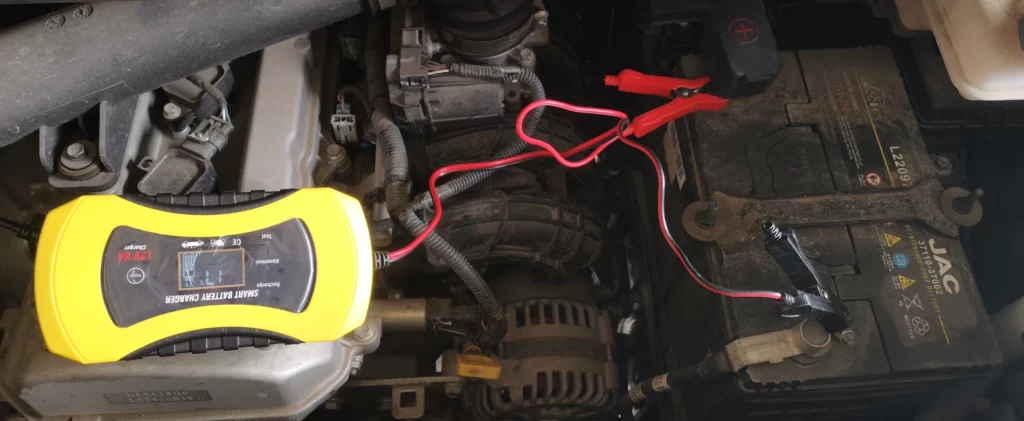
The housing of 12V8A ASL is made of high quality flame retardant plastic. It is in the bright colors of yellow and black. An LED screen in the middle shows the real-time battery level and the working status of the charger. A touch button is placed on the panel for the easy switching of the charging mode. The alligator clamps are in an integrated design. They can open at a large angle for easy connection to battery electrodes in different sizes. The plug of the charger support customization for different socket standards.
What Customers Are Saying
For 12V8A ASL, its effective automatic power off function received so much praise from its customers. Other praise goes to its multiple protection measures. Some users say that even though over voltage and overcurrent protection are not much required for daily use, but reverse protection is what they need. In addition, short circuit protection ensures that the battery will not be further charged when it is problematic. Some users complained that it is not water-proof. It is true, 12V8A ASL is not designed to be waterproof. But its performance is stable for indoor charging.
#2 Best Portable Car Battery Charger: 12V2A DVASL Car Battery Charger
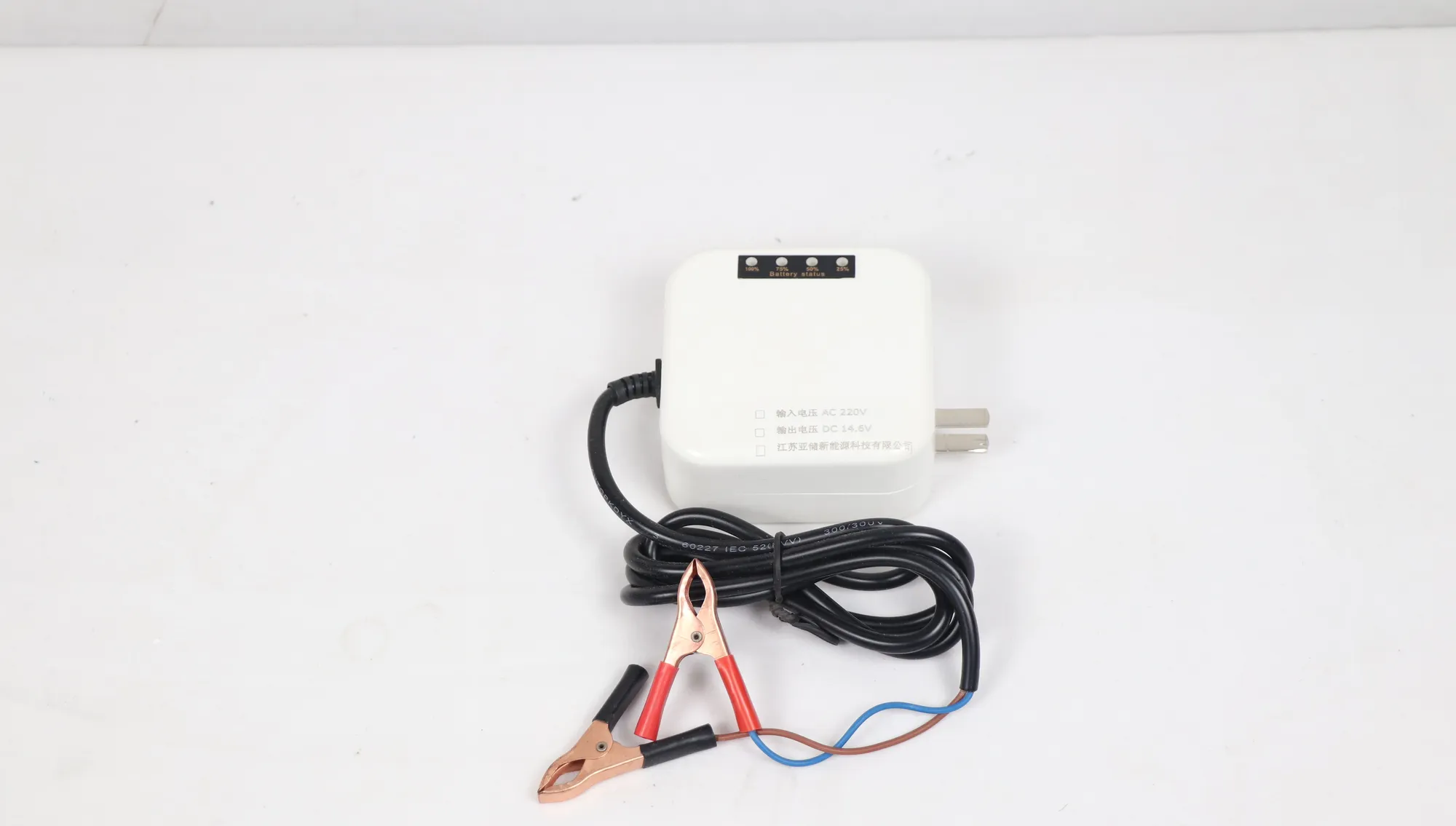
Pros
Compact and lightweight design
Intuitive charging progress indicator
Can be used under 110V and 220V voltage
Cons
A smaller clamp opening angle
Some customers commented that it gets hot in summer
Our 12V2A DVASL is a specially designed car battery charger. If you haven’t seen its output cord, you might believe it is a phone charger. It is in a compact design and super portable. It supports dual voltage charging, meaning it is capable of providing stable 110V and 220V charging current. Like many smart car battery chargers, it’s smart because can turn itself off when the battery is fully charged.
Key Features
Price: $3.50
Weight: 0.346kg
Amperage: 5-6A
Voltage: 14.4V
Battery Types: Standard (wet cell)/AGM/Gel/Ca/EFB
Warranty: 1 year
Our Experience
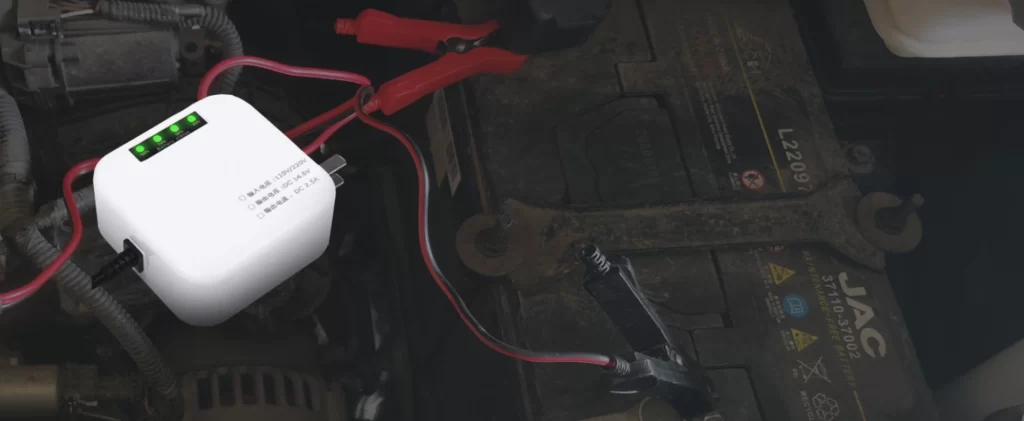
12V2A DVASL features a white square design. Its compact and lightweight design makes it weight at only 366g. Although it looks quite similar to a phone charger, its weight will tell you it’s not. Above its front panel, there are four charging progress indicators for 25%, 50%, 75% and 100%. It supports both 110V and 220V charging. So, it can be used in almost every country in the world. It has a flame-retardant shell to avoid any possibility of burning under extreme conditions. After disassembling its shell, we found that its high-frequency transformer is in pure copper, which means you can believe its stability.
What Customers Are Saying
“It’s the smallest car battery charger I’ve ever bought.” One of our clients commented. But he is not alone. Many customers said 12V2A DVASL is easy to carry on a car or a motorcycle. It is easy to be put under the seat of a motorcycle. Despite its compact size, its 5-6A output current allows it to quickly recharge a battery. Some customers say its alligator clamps look a little bit thin. But after the use for months, they are proved to be durable. Some customers said it was found to be hot during the summer days, but its output is still stable. Of course, as you can probably imagine, some customers say it would be better if the charging plug could be folded in.
#3 Best Multifunction Car Battery Charger: 12V LMS Car Battery Charger
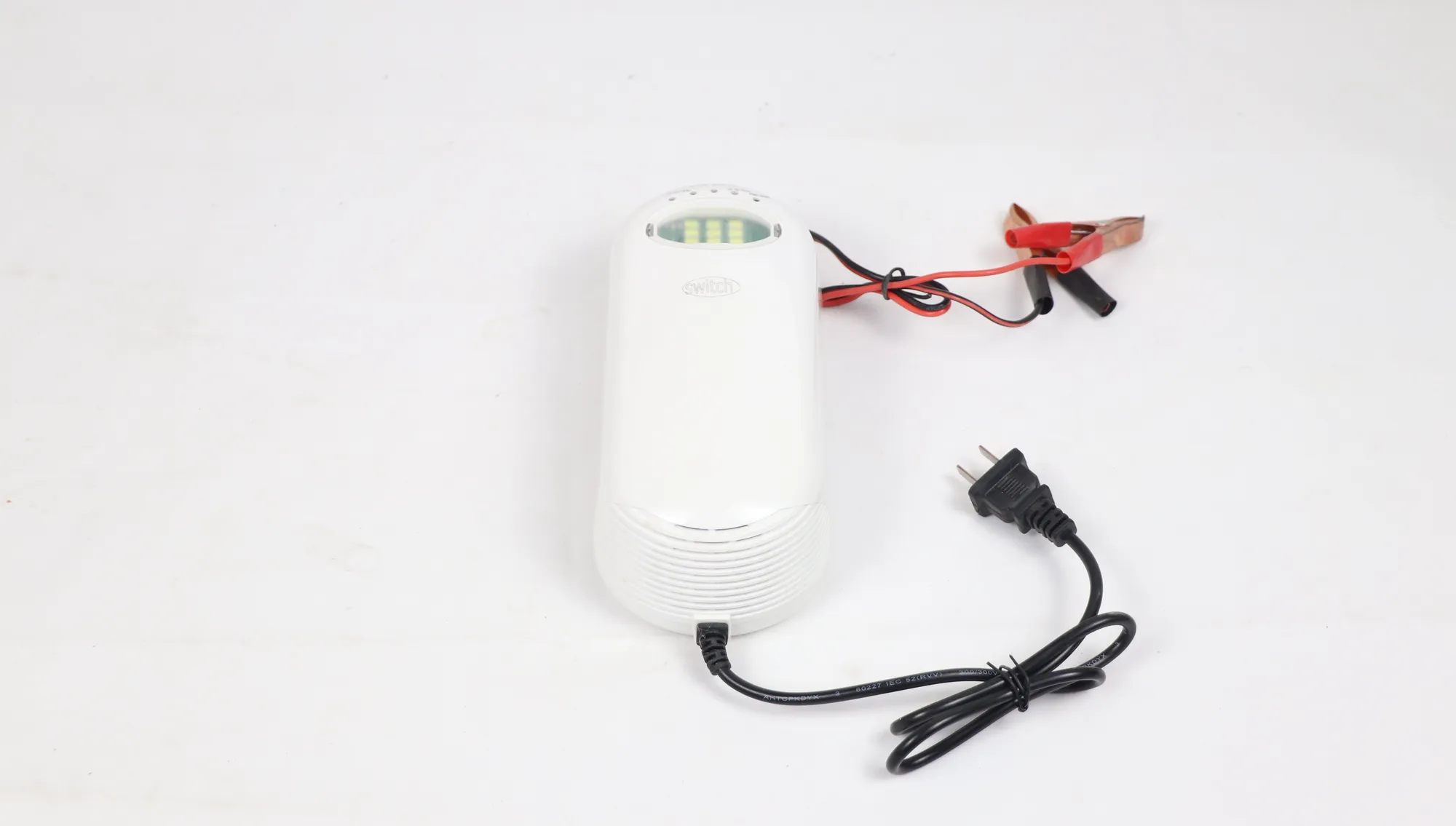
Pros
Easy-to-use touch control switch
Silent cooling fan
3-level LED lighting and music reminder
Cons
A few customers complained about its short cable
12V LMS is another highly portable car battery charger. It is in white. Instead of the most common digital number display, the 12V LMS has a marquee style charging process indicator at one end. Through a transparent window, you can see that its lighting function is achieved by 9 LED lights. It can be powered on and off by touching and supports 3-level brightness adjustment. Not only that, 12V LMS also features a traditional but rare-to-see music reminder to tell the user when the charging is finished.
Key Features
Price: $7.90
Weight: 0.474kg
Amperage: 10A
Voltage: 12V
Battery Types: Standard (wet cell)/AGM/Gel
Warranty: 1 year
Our Experience
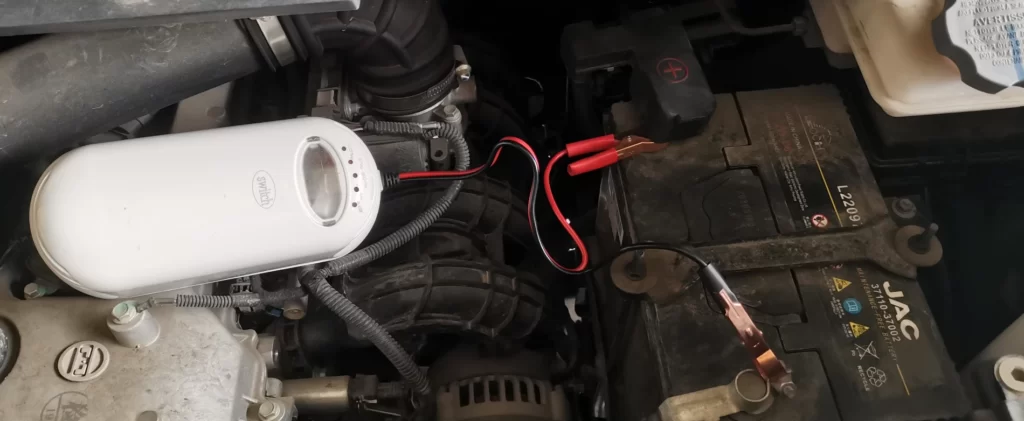
Its solid structure is the first impression when you have a 12V LMS in hand. It has a longer cable that can fully satisfy daily charging needs. Its alligator clips also look in high quality and can be used for long time. When it is used, its marquee style charging process indicator tells you the real-time progress of the battery at all times. When the charging is completed, you’ll get double reminder: a progress indicator and music. Its internal cooling fan produces only a super low level of noise. Its LED lighting even supports 3-level of brightness adjustment. It is very useful in dark environments.
What Customers Are Saying
Customers generally comment that 12V LMS seems to be reliable. And when they have it in hand, it is also the truth. The addition of lighting function makes it easier to use. There will hardly be any failure in its touch switch compared with their physical counterparts. Its efficient heat dissipation also makes it safe to be used in summer. Still, several users complained that its output cable was too short. An extended power cord will be needed to charge the battery if you don’t want to take it out from the car. Others complained that its clamps looked so-so. But considering its pricing level, they are completely acceptable, which has been affirmed by many users.
#4 Best Pulse Repair Car Battery Charger: 12V20A MCPR Car Battery Charger
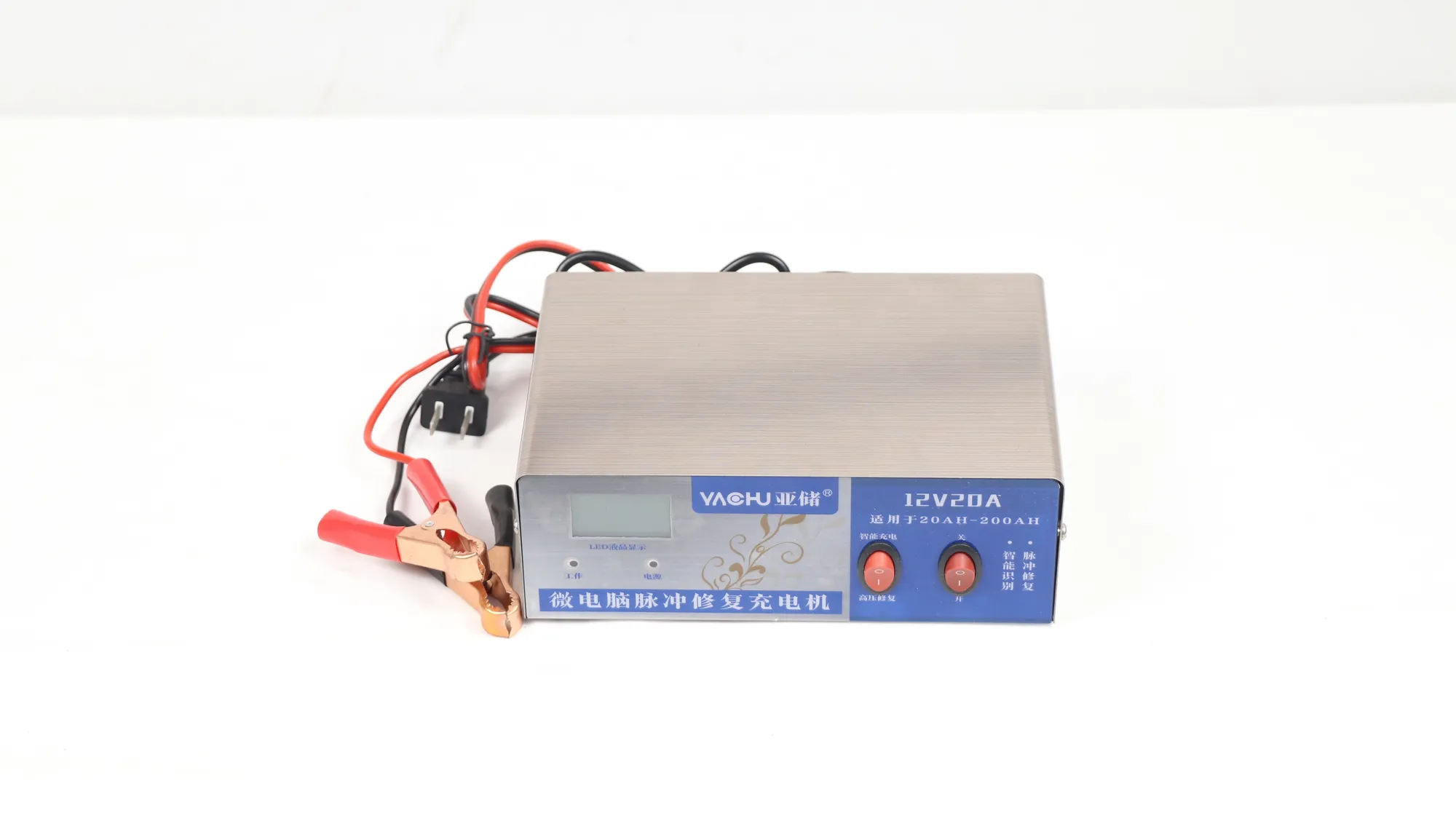
Pros
Can be used as a battery charger and restorer
Built-in PMW chip to ensure a stable current output
Multiple protection measures for safe use
Metal shell provides good heat dissipation
Cons
A customer complained about its imprecise workmanship
Some customers said it has low quality clamps
12V20A MCPR uses a microcomputer to realize its pulse repair function on lead-acid batteries. It has a built-in PMW (pulse width modulation) chip. 12V20A MCPR’s precise sampling capability and PWM technology make its output voltage stable and powerful enough for repairing lead acid batteries. Its automatic floating charging function also makes the charging current more stable. By doing this, the original capacity of the battery will not be affected. Furthermore, 12V20A MCPR also features a reverse protection and automatic shutdown function, making it easier and safer to use.
Key Features
Price: $9.90
Weight: 0.4kg
Amperage: 20A
Voltage: 12V
Battery Types: Standard (wet cell)/AGM/Gel
Warranty: 1 year
Our Experience
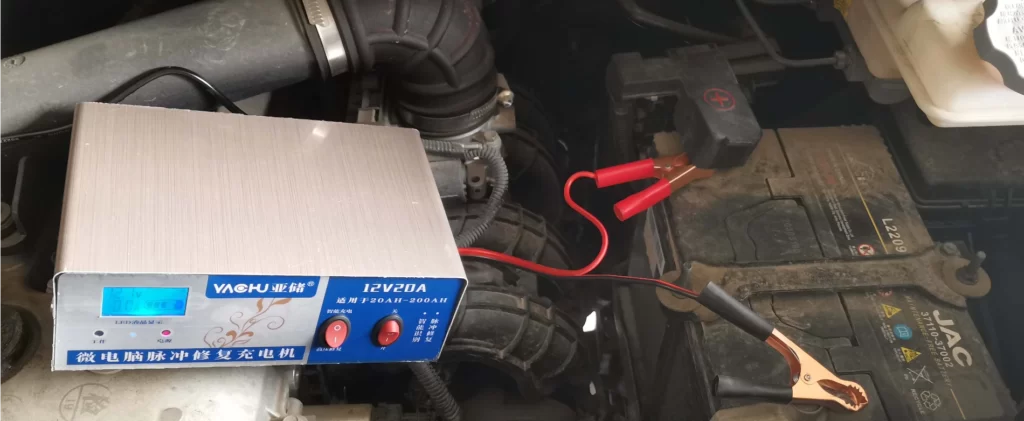
What should be highlighted in 12V20A MCPR is its powerful pulse repair function from its imported chip. Its output voltage can be maintained at 9-16V. It is a rational voltage level for almost any 12V lead acid batteries. Its 20A output voltage is sufficient to realize both fast charging and high voltage repairing in lead acid batteries. Its metal housing also improves the rapid dissipation of heat generated by the charger when it is working.
What Customers Are Saying
Customers have been complimenting the large clamps that come with 12V20A MCPR, saying they can be used on electrodes for a variety of lead acid batteries. Some customers say it works highly stably. One customer stated he used it to fix 5 lead acid batteries that were once dead. It is in lightweight and features a boat switch, making it easy to use. While its metal housing effectively dissipating the heat generated, some customers also complain that it is easy to leave marks when their hands are oily. But it didn’t stop customers from raving about its convenience and durability.
#5 Best Car Battery Restorer: 12V6A SL Car Battery Charger and Restorer
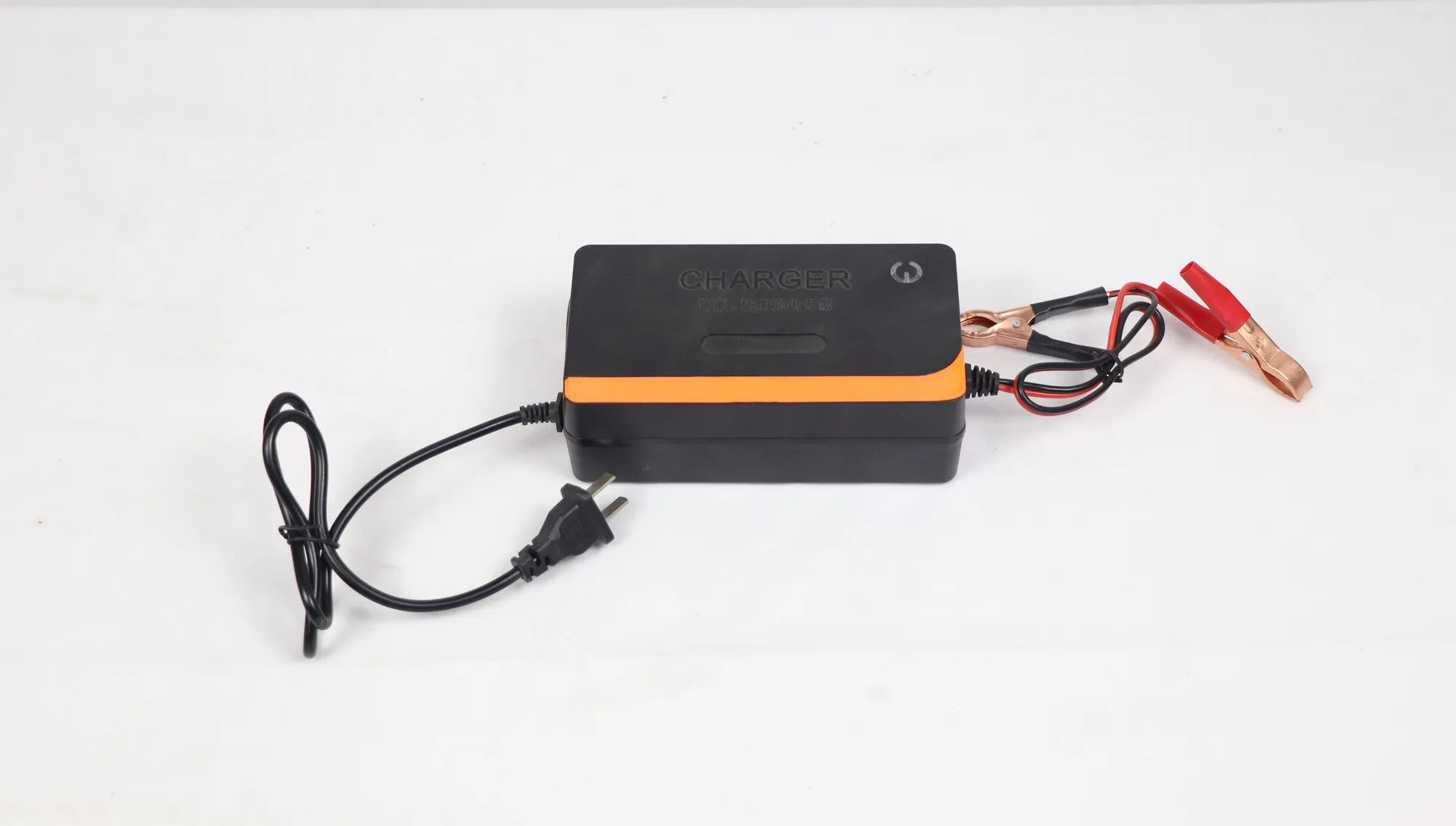
Pros
Easy to use
Can recharge a completely dead battery
Automatic shutdown function prevents damage to the battery
In high quality for long-term use
Cons
Features a short output cable
This 12V6A SL can charge lead acid batteries and help them to replenish their capacity. It has an operational simplifier technology to ensure the accurate control of charging current so as to effectively avoid the overcharging of a battery. Its built-in imported pulse width modulation chip can ensure the output voltage is neither too high nor below full value. 12V6A SL can detect the battery’s charging progress with its automatic floating charging function and ensure that the battery can be fully charged without being damaged.
Key Features
Price: $5.59
Weight: 0.4kg
Amperage: 6A
Voltage: 12V
Battery Types: Standard (wet cell)
Warranty: 1 year
Our Experience
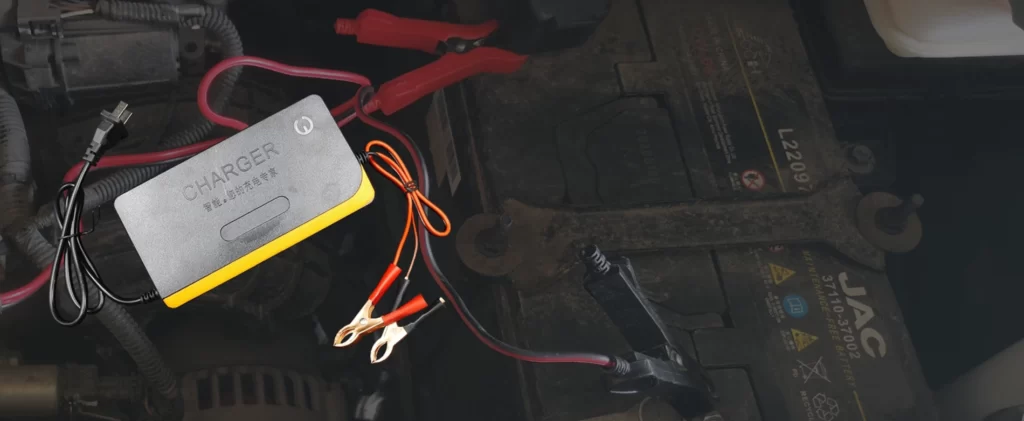
12V6A SL comes in a case in black and yellow. It looks simple but still feels solid. After using it, we found the operational simplifier technology in this 12V6A SL makes its out voltage more accurate. When the battery is fully charged, its automatic power off function can prevent any further charging from damaging the battery. Its reverse protection guarantees that even the positive and negative diodes are reverse, there will not be any problem.
What Customers Are Saying
A 12V6A SL user said its generic exterior design doesn’t mean it isn’t efficient. He repaired a lawn tractor battery that had been in the outside and not been charged for more than a year. The charging lasts 48 hours. And after that, it became usable again. It is also unexpected when it is used to repair vulcanized batteries. Some clients say they used it to recondition borderline unhealthy batteries and brought them back to life. Although some batteries are in terrible conditions that they are impossible to be fully recovered to their original status, he was satisfied with the result. Although there is no abundant functions to measure and adjust lead acid batteries, its high quality clamps and long enough cables are enough to satisfy a great majority of its users.
How Do Car Battery Chargers Work?
By using a process called induction charging, a car battery charger can turn an uncharged battery into usable. It works by creating an electromagnetic field between two electrodes that transfers energy from the power source to the battery. A car battery charger will be plugged into your mains electricity socket and then attached to the battery terminals. They can be used to charge a battery that runs low or to maintain a battery that is not being used.
Car Batteries
Most modern cars use 12V lead acid batteries. But there are also other types of car batteries with different voltage levels used in cars. Therefore, when choosing a charger for a car battery, you need to ensure that the battery type and voltage level are consistent with the parameters of the charger you are about to purchase.
- Wet cell
- AGM
- Gel
- EFB
- Deep Cycle
Chargers for lead acid battery charging are usually compatible with wet cell, AGM, and Gel. But because of the different reaction processes inside, they cannot be used for the charging of lithium-ion batteries. When a lithium-ion battery is charged with a lead-acid battery charger, it will be overcharged. On the contrary, when a lithium-ion battery charger is used to charge a lead acid battery, it will not be fully charged. Only a few car battery chargers are compatible with both types of batteries.
Amps & Voltage
The level of electric current is usually expressed in amperage. The number of amps determines how fast it can charge a battery. When charging a battery, as long as it is acceptable for the battery, the higher the amperage, the better. You can use a chargers with a higher amps than the batteries.
Voltage is another measurement of the current. If amps describes the volume of electrons flowing through a circuit, then the voltage is the force that moves them forward. Like amps, voltage of a car battery charger should be slightly higher than that of the battery. However, higher voltage is not always better, and it is generally suggested not to use more than 16V to charge a 12V lead acid battery.
Trickle Charging and Desulfation
Some car battery chargers can provide additional functions than basic charging, in which the most common are trickle charging and desulfation.
Trickle charging means that after a battery is connected to the charger, the charger will charge the battery with a small current when it detects that the battery needs to be charged. The process will continue until it is fully charged. It is used to recharge a battery to prevent it from depleting due to infrequent use.
Sulfation in a lead acid battery occurs when it is fully discharged. It refers to the accumulation of lead sulfate on the surface of the electrodes. When it happens, it will be more difficult to charge the battery. Some chargers with desulfation function can remove the buildup by applying a higher voltage to the battery.
What is Included in the Test
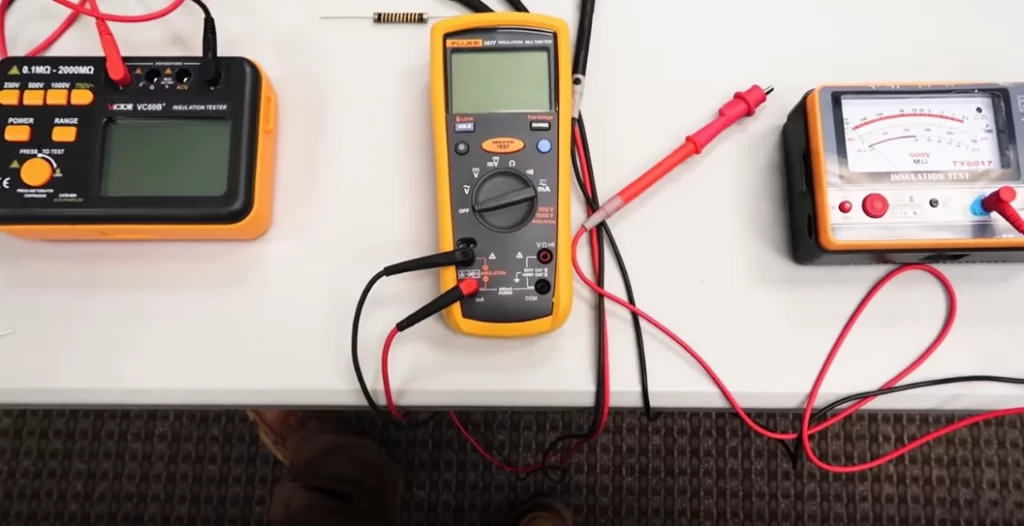
Our chargers are usually tested from the following aspects:
Compatibility
There are several types of lead acid batteries used in cars including wet cell, gel, AGM, etc. Not all car battery chargers will work with all batteries. When testing a particular car battery charger, we will note which battery types it can be used to charge. In addition, their performance will be better if they have various protection measures or support trickle charging.
Charging Speed
In addition to which batteries a charge can be used on, you also need to consider how long the charging will cost. The voltage and amps of a charger determine their speed performance. To charge a 12V lead acid battery, the charger must output at least 12V voltage. The higher the voltage, the faster the charging will be. But too much voltage can also damage the battery. The constant maintenance of the output voltage will determine the charging speed and battery health. An inaccurate prediction of a charger’s charging speed can easily lead to the overcharging of a lead acid battery. That’s why a car battery charger should be able to turn itself off when further charging is not required.
Ease of Use
Long enough power cables and durable alligator clamps are basic requirements for a car battery charger to be easily used. In addition, a user friendly interface and a clear manual are also necessary.
How We Do the Test
When we test a car battery charger, we will first connect it to an outlet and then connect its output line to multiple batteries it claims to be compatible with one after another. Next, we will use a multimeter to measure whether the output voltage and current are within the range that the battery can accept. We will record the performance data of each charger in detail. We will also test their performance under different temperature conditions and humidity conditions.
Why You can Trust Us
Dozens of popular car battery chargers and other products will be tested in our lab every year. With carefully conducted test, we can get the genuine and accurate data. Every effort we made is to ensure that each product will be thoroughly tested before it is recommended to our customers.
Other Car Battery Chargers We Recommend
1.1200W Waterproof Battery Charger
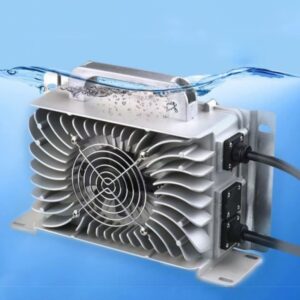
This car battery charger features an aluminum alloy shell which is waterproof, shock-resistant, acid fog-resistant, and dustproof. Its aluminum provides a decent heat dissipation. The voltage and current delivered to battery can be precisely controlled. Its automatic shutdown function can promise the battery be fully charged without being overcharged. There are overcurrent protection, overvoltage protection, short circuit protection and misconnection protection measures to ensure safety. A 3-color LED indicator shows the charging process and battery status in real time. It is CE and RoHS certificated. With mounting holes, it can be installed to a fixed outdoor charging location. Can be used for charging lead acid batteries used in cars, boats, RVs, motorcycles, lawn mowers, ATVs, jet skis, wet basement, snowmobiles and others.
2.12V-24V One-Click Intelligent Pulse Repair Car Battery Charger
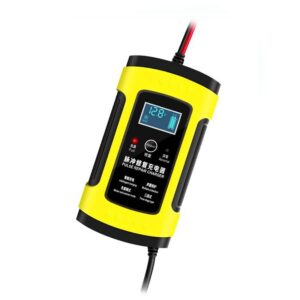
Supporting dual charging voltage, this self-adaptive car battery charger can be used to charge 12V and 24V lead acid batteries. It is able to switch between summer and winter charging modes according to different temperature conditions. It has a one-click intelligent pulse repair function for the repairing and restoration of sulfated lead acid batteries. Its LED screen can display its working status in real time. Quality parts are used including pure copper high frequency transformer, silent cooling fan and fully wrapped alligator clamps. The shell adop ts flame-retardant plastic to ensure safety.
3.12V Auto-stop Smart Lead Acid Battery Charger
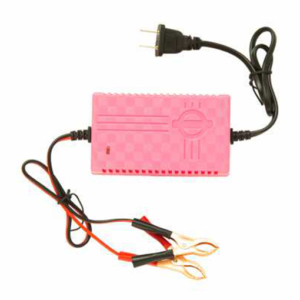
Even as a basic model, this lead acid battery charger in pink color also has an automatic shutdown feature. It is a universal car battery charger compatible with general lead acid batteries including the standard wet cells, AGM, gel, etc. It is made of high quality flame-retardant plastic shell, pure copper core cable and durable alligator clip. With its spark-free design, no electrical spark will be generated when it is connected with a battery. The operation is simple. After connected to a power socket, it can be connected to the battery according to the correct terminals. When it is being charged, the battery’s performance and health can also be optimized.
Best Battery Chargers: FAQ
The most common sign that a lead acid battery is sulfurated is that it becomes less efficient. There will be a problem with its proper charging. Usually, poor air conditioning and dim headlights are the performances of battery sulfuration. If the battery voltage tested by the multimeter falls below 12.6V, it means that the battery is undercharged. This is often the result of battery sulfuration. If you open a sulfurated lead acid battery, you’ll find that the battery cells and the separators inside the battery tend to gray, grimy and indistinguishable. Under normal conditions, however, both the battery cells and the separators are clean, and there will be visible boundaries between them.
Flooded batteries are the most common type in all lead acid batteries. They are also called wet cell batteries. Instead of being sealed, these batteries have small holes in the top called manholes that allow the electrolyte to be added to the cell. Compared with flooded batteries, gel cell batteries are sealed. Gel cell batteries do not have manholes. So, that means there is no need to add electrolyte to these batteries. AGM batteries are newer members of the lead acid battery family. They’re similar to gel cell batteries but smaller in size. Generally, you can simply tell the type of your lead acid battery by reading its label.
The difference is that a float charger has certain circuit to prevent the battery from being overcharged. This circuit can monitor the voltage of the battery while it is being charged. That means if the charger detects that the battery voltage has reached the maximum during the battery charging process, the charger will automatically turn off and will not resume charging until it detects a drop in the battery voltage. As a result, they can stay connected to batteries for long periods of time. A trickle charger, on the other hand, will keep charging the battery whether it’s fully charged or not. So, you need to manually disconnect the battery when it’s fully charged. If a trickle charger is left connected to the battery for too long, the problem is that the electrode within the battery will be accelerated to evaporate, causing damage to the battery plate.
You can find the battery voltage information by looking at the manual of the battery or the vehicle. The manufacturer of the battery will set the most appropriate charging voltage for the battery according to its physical condition. Most cars, motorcycles and ships are equipped with 12V lead acid batteries. 6V lead acid batteries are commonly used in some scooters and lawn mowers. When charging a battery, the charger should be selected according to the voltage setting of the battery. Improper selection of battery chargers will lead to overcharging or undercharging of the battery and have a negative impact on the long-term and stable use of the battery.
Lead acid batteries for cars contain sulfuric acid, and in some cases hydrogen and oxygen. Since sulfuric acid leaks can cause skin damage, protective equipment such as goggles and rubber or mechanical gloves should be worn when adding sulfuric acid to lead acid batteries to avoid direct contact with sulfuric acid. When dealing with lead acid battery problems, the work should be carried out in a well-ventilated place. Also remember not to smoke or generate electric sparks nearby to avoid potential battery fire or explosion. Do not attempt to open a permanently sealed type of lead acid battery to risk an explosion. When a lead acid battery is connected to a vehicle, the positive electrode should be connected before the negative electrode. And when it is disconnected from a vehicle, the sequence will be reversed. The negative electrode goes first, followed by the positive electrode.
You can do this when you are using a car battery charger that can turn itself off. It will automatically switch to maintenance mode when the battery is fully charged. This is not recommended for basic model chargers that don’t have this feature. If a battery is fully charged and continues to be charged, it can easily be overcharged.
This is not recommended. A charger should be selected according to the size of the battery. It will takes longer time to charge a battery when using a smaller changer than needed. It will not guarantee the battery’s performance or extend its life in the best way either. Using a larger charger also won’t make the battery properly charged, which can also affect the battery.
Yes, you can keep it in your car if your car battery charger is spark proof, reverse polarity protected, or electrically safe. Otherwise, to ensure the safety of the battery and yourself, it is suggested to take the battery out of the vehicle before charging it.
Yes, this is normal when the chargers are working hard in its bulk charge phase.
Neither. Both lead acid and lithium batteries need to be charged by battery chargers designed and manufactured for each type of battery.
You can estimate the charging time by dividing the amps the battery needs to replenish by the charger’s amp output. Let’s say you have a 100amp hour lead acid battery that is 50% down, then you need to charge it for 50 amp hours. If you have a 10 amp charger, then divide the 50 amp hours by the 10 amp hours of the charger, you get 5 hours. In fact, many car battery chargers will reduce the charging rate when it is 80% or 90% charged. So, in this case, the charging time will be in close to 6 hours.
AGM and flooded batteries usually use a same charging profile. Although some chargers distinguish AGM from flooded batteries by a single switch, most car battery charger manufacturers agree that it is possible to use the same type of charger to charge the 2 types of batteries.
A trickle charger is generally considered to be a non-intelligent charger with a fixed amp output. They simply provide a fixed charging rate without taking any information from the battery. Over time, this can lead to the overcharging of the battery. So when you use a trickle charger, if it’s not a smart type, it should be watched for safety. A microprocessor charger can continuously obtain information from the battery during the charging process and adjusts the charging current in real time. They keep the battery fully charged without causing an overcharge. It can be connected with a lead acid battery for a long time. However, due to the evaporation of electrolyte, the flooded type lead acid batteries still need to be checked frequently.
Although it may vary depending on different manufacturers, today’s 12V lead acid batteries typically require a minimum voltage around 14.5V to guarantee a full charge. In many vehicles, their AC generators consistently delivers 14.4V to the battery during normal operation.
A new car battery charger will release such smell when it is used for the 1st time. This is normal. And it will soon be gone.
These batteries look different from their appearances. The most common lead acid batteries today are standard wet cells. They are usually made unsealed and electrolyte can be added to the inside through a hole in the top housing of the battery. Gel cell batteries are sealed and cannot be refilled with electrolyte. They have smooth tops and no access holes. AGM (absorbed glass mat) batteries are sealed like gel cell batteries. But they are usually smaller. You can identify an AGM by their more compact size.
Lead acid batteries for different purposes have different voltage settings. Most lead acid batteries used in cars and boats are 12V while some motorcycle and lawn tractor batteries use 6V types. The voltage information can be known by checking the battery or vehicle’s owner’s manual. The value of the charge rate voltage is determined by the manufacturer of the battery. Voltage deviations from the recommended value can result in undercharging or overcharging, which can affect battery performance and service life.
If your battery won’t be normally charged or won’t stay charged as long as it used to, then it’s time to repair or replace it.
For some car battery charger models, the fan will keep working at all times to keep the built-in transformer and circuit cool. When using a charger, there should be no obstacles nearby to affect the heat dissipation by the fan.
Not necessarily. Many energy-saving products use a lightweight design and more efficient transformer. By doing this, their weight can be reduced than the older types.
The maintenance mode of the charger will be turned on after a battery is fully charged. When it is working in this mode, the battery will be fully charged by the charger with a small current. If the battery’s voltage level drops below a certain level, the charger will start charging until the battery voltage returns to a certain level, and then switch back to maintenance mode.
Many cars have their batteries not fully charged when they are parked. To ensure that your battery can be fully charged, you should use a charger to charge the battery at least once or twice a month. When a car is left idle for long, make sure to start it at least once a week and let it run for more than 10 minutes.
When a car battery charger is connected to a battery, its positive terminal should be connected first, then the negative. When it is removed from a battery, the negative terminal should be disconnected first and then the positive.
Sulfation is the build-up of lead sulfate crystals within a lead acid battery. It is the number 1 reason of early failures in lead acid batteries including flooded batteries and AGM. A sulfated lead acid battery can lead to the loss of cranking power, longer charging time, excessive heat build-up, shorter running times between charges and shorter battery life.
Lead acid batteries store electricity based by continuous chemical reactions. And extreme temperature conditions will harm their performance. When it is cold, a vehicle engine requires more power to start, which will accelerate the drain on the battery. High temperature is also an enemy. High temperatures under the engine hood can accelerate corrosion inside the battery and accelerate the evaporation of the electrolyte, resulting in a reduced battery capacity and shortened service life. A car battery charger with a winter charging mode and a summer charging mode can take better care of the battery and provide a better maintenance.

